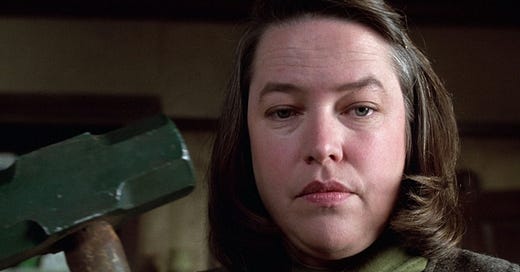There’s been a trend within the last decade in film fandom to focus on aesthetics, or how beautiful something looks. We all know that Gen-Z goes gaga for the term, but so does the general twitter-sphere and by extension the studios that adhere to social media trends.1 This has cultivated a boom industry of media accounts that post beautiful shots from films, the most notable of which is One Perfect Shot – which was popular enough to become its own HBO Max series. As fun as it is to admire elegant cinematography, the importance levied on these frames has taken a toll on the film industry – skewing the balance from directing and script work to “oooh they’re using neon-colored gel filters.” How often have you selected a film on your streaming service with gorgeous visuals, only to be bored out of your skull? It’s a disconnect that threatens to let elegance choke out entertainment value or real depth.
All of this is what ran through my head while watching Kathy Bates chuck a stool over James Caan’s head in Rob Reiner’s Misery (1990). It’s not an elegant film, but it's a goddamn entertaining one.
Set in the snowy mountains of Colorado, famed romance novelist Paul Sheldon (James Caan) has just emerged from his writing cabin with a new novel – his first without his star series character, Misery. While on his cross-country drive back home to NYC, he crashes off a mountain during a blizzard, nearly dying if not for the help of recluse Annie Wilkes (Kathy Bates). What begins as a nurse caring for the injured New Yorker becomes a captive situation, as Misery super-fan Annie is not willing to let her favorite author leave her care.
Based on the Stephen King novel of the same name, King has stated that Annie’s control over bedridden Paul is supposed to represent the clutch that drugs and alcohol can have over the creative.2 Yet like any good piece of art, the relationship is open to interpretation. Beyond the struggles of addiction, which was largely excised from the film adaptation, there is the obvious critique on fandom – which has only grown more poignant in the three decades since its release.
Outwardly, Annie is charming and pious and someone who can honestly get a fit off.3 She, like many fans of many properties I won’t name, views her investment in the Misery series as something unique and personal. Nobody knows the character of Misery like she does. Annie can call up bits of Misery-lore that Paul doesn’t even remember, demonstrating the void between a seemingly uncaring creator and an all-too-caring fan.4 This blows up further when Annie finds out that Misery dies in Paul’s latest book, sending her into a rage – and demanding that he change the ending to fit the idealized one that she imagined. I don’t want to spend any more time on nerd culture than I have to, but I’ll just remind everyone that a fan campaign to remake Rian Johnson’s The Last Jedi earnestly attempted to fundraise 200 million dollars to redo a movie they didn’t like.
Another interpretation, one that utilizes Reiners’ decades of comedy chops, is that Annie is how New Yorkers see the rest of America: rural, cattle-like, cheery until they gore you to shreds. Seen through the bleary eyes of Caan’s Manhattanite creative, Annie is the Midwestern terror which lurks beyond his civilized island – Ned Flanders with a sledgehammer. Caan, who was not the most agreeable actor in Hollywood, is emotionally and physically restrained here – forced to channel his frustration into pained smiles and watery eyes. At first, these are simply polite responses to the mannerisms of his yokel nurse, until they quickly become subdued recoils of fear.
Both James Caan and Kathy Bates are chewing up the scenery to phenomenal effect, leading this two-hander to be something quite rare in cinema: a triple threat of prestige, horror, and hilarity. You only need to watch Bates storm into Paul’s bedroom with edits of his hostage-rewrite and deadpan that it all needs to be rewritten “except for the part of naming the gravedigger after me, you can leave that in'' before you hand her the Oscar. With its hilarity matched with its ankle-shattering terror, Misery is in good company with The Silence of the Lambs and Get Out – movies built for the live screams and laughs of a packed theater.
Misery might be one of the best adaptations of King's work. Not in terms of closeness to the source material, but in capturing the thrill of reading a well-used paperback. Snowy peaks and piney forests are shot in broad daylight, while the interiors of Annie’s cabin have a sort of flat and cozy feel to them. Beyond the canted angles and push-ins on Kathy Bates’ cross-eyed rage, aping classic Hitchcock horrors, Reiner shot the film without much flair. This isn’t a film that’s concerned with appearance, it's a movie that’s concerned with scaring its audience – which is an admirable trait as far as I’m concerned.
Misery is available to stream on HBO Max.
Special thanks to Austin Smoldt-Sáenz, Elena Bruess, Joshua De Lanoit, and Max Seifert.
Just search the tag “aesthetic” on Tiktok, Twitter, or Instagram and you’ll see what I mean.
King famously struggled with substance abuse throughout his early success.
Creating an Annie Wilkes Pinterest board of cable knit sweaters, overalls, and boyfriend flannels.
Very similar to when an attendee at Blizzcon corrected World of Warcraft developers on their own lore.






